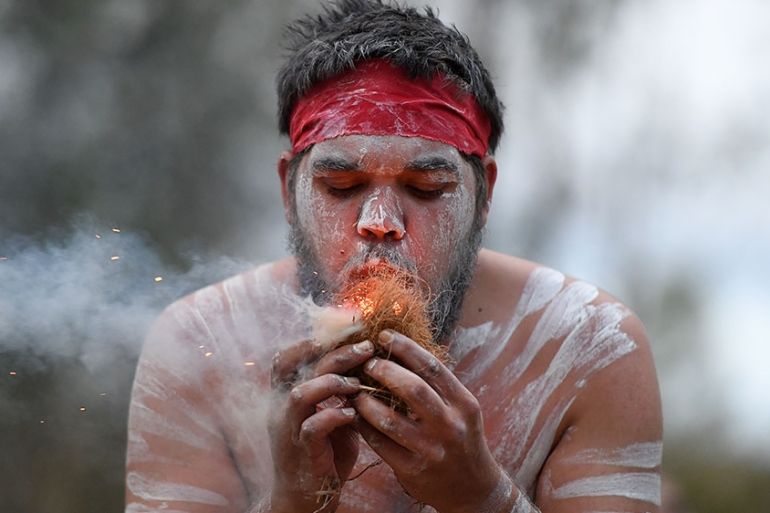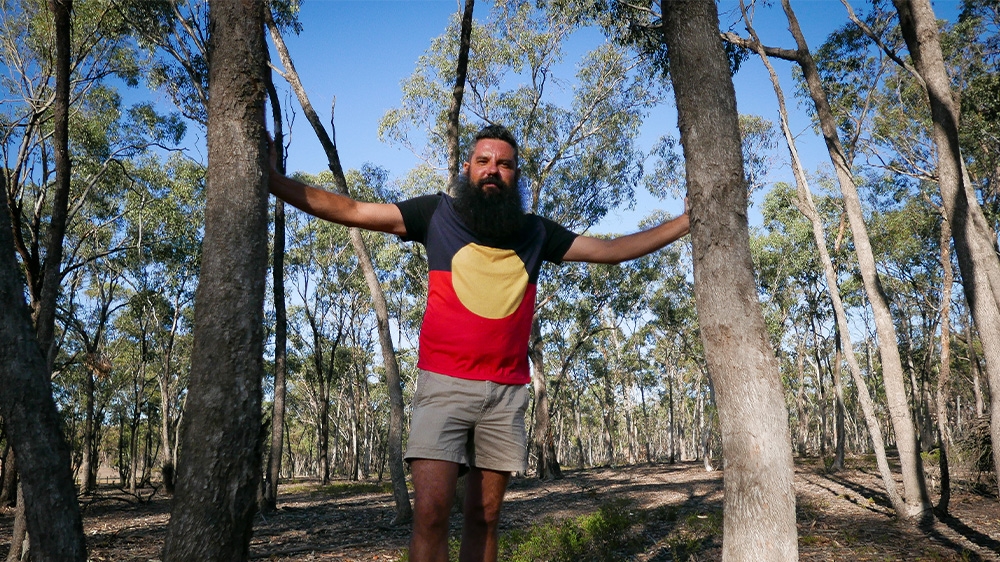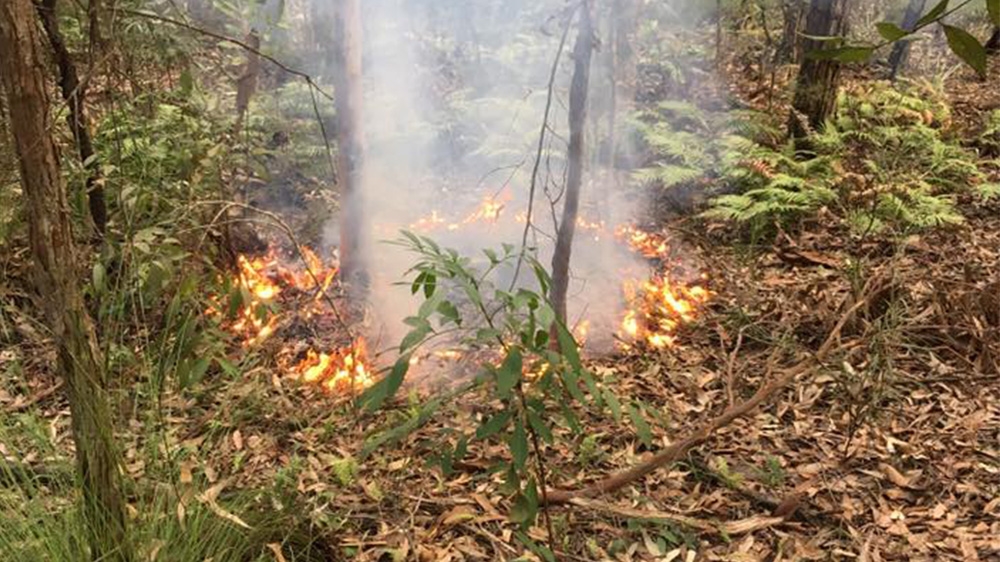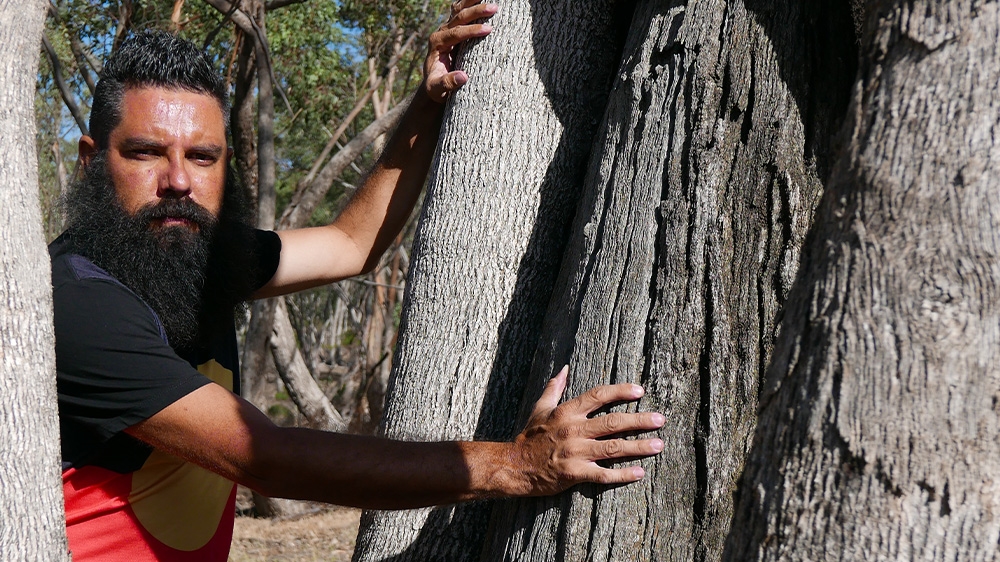How Australia’s Indigenous people can help the country fight fire
Fire plays a central role in indigenous life and could hold the key to better management of bushfires in Australia.

Djandak Wi, Australia – Aboriginal park ranger Trent Nelson walks through the bush, demonstrating traditional fire techniques.
He mimics the lighting of small spot fires on certain shrubs – fires his ancestors have lit for thousands of years before him.
Keep reading
list of 3 items‘A shape in the ash’: Bushfires destroy Australian wildlife
Extreme weather: More severe events on the way, UN says
“What happens, is when the fire goes through, a lot of these plants don’t get impacted,” he explained.
“The fire only gets to probably about [a foot] high as it goes through, so these are protected and they can grow. It also protects the trees in the canopy.”
In the Dja Dja Wurrung traditional lands in the northern part of Australia’s Victoria state, this section of the bush is known as Djandak Wi, meaning “fire country”.
When Aboriginal people use the word “country”, they refer to the distinct region they come from, with pre-colonial Australia akin to an indigenous version of Europe.
And while catastrophic bushfires rage across much of Australia, the “country” of Djandak Wi is eerily quiet and peaceful.
Sounds of the bush
The soft sound of insects scurrying in the undergrowth is interrupted only by the wind in the trees overhead and the distinct call of a kookaburra.
The gentle fragrance of eucalyptus hangs in the air, a stark contrast to the pungent haze of smoke that engulfs much of southeastern Australia.
This is the bush that Australians – and millions of tourists alike – have come to know and love.

Yet this is also the bush that Indigenous people maintained for thousands of years prior to colonisation, in particular, through the use of fire.
“For our country to survive and for our people to survive on country, techniques of fire were used,” Nelson said.
“We know from research we’ve done, from over 200-plus years of documentation, that fire was actually in our landscape.”
Nelson describes how Aboriginal people would move through the bush, systematically setting undergrowth alight, in order to promote the growth of new plants, rid the bush of flammable materials such as bark and leaf litter and attract animals to hunt.
In fact, the practice of lighting fires was such a constant feature of daily life for Indigenous people, that the first European colonisers noticed.
|
|
“When [the] first settlers moved into our area they actually witnessed fire being put into the landscape[and] smoke plumes right across our country,” he explained.
Nelson leads a small team of Aboriginal park rangers in northern Victoria whose aim is to reintroduce what he describes as “cultural burning”; traditional techniques using fire to manage the landscape.
While it is acknowledged that the impacts of climate change and the continuing drought have contributed to this year’s fires, Trent hopes that the wider adoption of “cultural burns” will reduce the potential for such large-scale fires in the future.
Reading the land
But cultural burning is not only about avoiding bushfires.
As Nelson explains, fires were traditionally lit “for cultural purposes – for hunting and regeneration of food and fibre in the landscape.”
“Food for us to survive is not just the animals that we hunted – kangaroos, emus, fish – but also the starchy fibrous tubers that grow in the ground. They actually need burning on a regular basis to provide that propagation of the seed and seed banks.”

Regular burning also helped clear dry leaf and bark litter – highly flammable materials that build up on the floor of the bush and have contributed to the spread of Australia’s recent fires.
While park rangers do regularly burn large swathes of the bush in order to reduce such fire hazards, Nelson says cultural burning is different.
A normal “burn off” typically aims to reduce fire hazards by burning large areas at a high temperature, essentially setting fire to the entire ecosystem.
In contrast, Nelson’s team will instead choose smaller areas and specifically burn certain plants at particular seasons.
He says that his team creates a “mosaic pattern” on the ground and will not set fire to every piece of leaf litter, choosing which plants to burn and giving organisms and animals the chance to escape or find shelter.
“We actually use a [fire] pattern that adheres to the land and what is required in terms of fire in the landscape,” he said.
“We ‘read’ the country as well – we don’t put fire in the landscape when it’s not ready. We make sure that it is ready and will relate to that fire and that impact.”
Nelson said is also important to protect the tree canopy, in which much of the “life” of the bush lives.
“The way we put fire into the landscape, we have to be careful to put it into the right areas. Because fire is a tool and a technique that we use. We make sure that when we put fire into the landscape that it doesn’t actually harm the trees and doesn’t actually get into the canopy.”
‘Fire is a tool’
The use of fire also has particular cultural protocols, and as Nelson repeatedly states, was not simply used as a way to mitigate catastrophic bushfires.

However, Nelson says that it is evident that Aboriginal fire management techniques do reduce fire risk, and that Indigenous people should be acknowledged and involved if Australia is to tackle the fire threat it faces.
“Fire for us is a tool. We know that it was used in the landscape for thousands and thousands of generations. For us, fire is not to be afraid of.”
“I’d like to see more traditional owners across [Victoria] and Australia being involved in fire practices on country, and just being part of the conversation and having our voices heard.”
“Because we’ve got a lot of knowledge. Our old people managed the country for thousands of years and that knowledge is still embedded in what we do as Aboriginal people.”
Further north in the Blue Mountains, which has been ravaged by this summer’s fires, Wiradjuri traditional owner Dennis Barber is also on a mission to bring back cultural burning.
Like Nelson, Barber is a professional park ranger and firefighter, who also works for an Aboriginal-run fire programme called Koori Country Firesticks.
|
|
He says he was introduced to cultural burning by elders from Cape York in 2010, and that it was “unlike anything I’d ever done in a professional capacity.”
“That’s when I realised that what I’d been doing as a professional firefighter – lighting up the bush with torches and doing hazard reduction – was not even close to what traditionally the approach was.”
Bush as fuel
Barber also maintains that the use of cultural burning could contribute to a reduction of large-scale bushfires.
“It doesn’t matter where I go – I can go to any National Park and more often than not you find huge fuel loads in the bush. Tourists think it’s lovely, but all I see is rubbish. All I see is a ticking time bomb, knowing the amount of fuel sitting in that area of the national park. And sure enough, what we end up with are these wildfires.”
While he acknowledges that climate change and drought are all contributing factors to this year’s crisis, “the actual management of that country is a missing component.”
Barber is also concerned not only about the loss of ecosystems, plant and animal life, but also the cultural heritage that the bush contains, including one sacred area in his own country that he suspects has now been lost to the fires.
“We are just wiping out our flora and fauna, micro-organisms and everything. We do talk about the koala and the loss of iconic animals, but country is about everything. There are so many aspects to country [such as] the bush medicines that Aboriginal people relied on.”
While Prime Minister Scott Morrison has recently proposed that a Royal Commission into the fires be established, what role Aboriginal traditional owners will have in the discussions has yet to be determined.
Barber – like Nelson – acknowledges cultural burning is not the “silver bullet” to avoid such fires in the future, but he is convinced that tapping into the knowledge of the Aboriginal people who have lived on the land for generations will help modern-day Australia better manage its unique landscape.
“Do you really believe that Aboriginal people would have survived in this country had we allowed it to burn like it is burning now?” he asked.